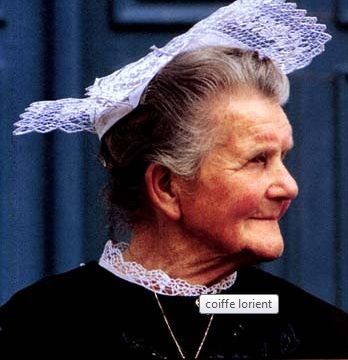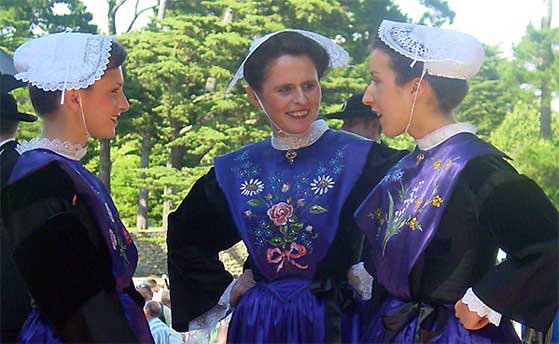Hello all,
Today I would like to continue my series on Breton Costumes by looking at the province of Gwened, or Vannes in French. As Gernew or Cornouailles was named after Cornwall, so Gwened is named after the Welsh province of Gwynedd, which was once a Kingdom in its own right, again emphasizing the British origin of the Breton People. The French name Vannes is also derived from Gwynedd, via the Latin form Venedotia. Here is a map showing the location of Gwened.
Bro-Gwened
Pays Vannetais in French
Most of Bro Gwened is traditionally Breton speaking, but the eastern part lies within the Gallo linguistic area. Nonetheless, this was always considered to form one region.
Bro Pourlet
Pays Pourlet in French
Note that this is a Breton word, not French, so the final T is pronounced. Earlier it was called Bro or Pays Gwenedour. It is also often called by the name of its main city, Ar Gemene, or in French, Guémené-sur-Scorff. The costume is distinguished by rows of many buttons on the bodice, vest and jackets of both men and women. Thus this costume is sometimes called 'the thousand buttons'. Here is a pair of drawings of the costume as worn in 1844. In this region, as in so many others many colors were used in this era.
Here are just a few images of the more modern version of the coif.
Another type of headgear was worn for more everyday occasions. This is called the capot, and basically consists of a closed cylinder with a kerchief attached to the back. It is worn over a plain version of the underbonnet.
The Gavotte of Pourlet is renowned for the high leaps of the men. Here is a group from Pontivy [in Pontivy costume] performing it.
Patches of velvet were applied to the outerwear, the composition depending on locality. Men's jackets were made of either black or white wool under these patches.
A few more images of this costume.
Bro Pondi
Pays Pontivy in French
The modern coif developed simply by shortening the old coif and adding lace. Here is an intermediate example. No extra loops were added.
The capot was also worn in this area.
The men's costume is typified by the 'white sheep', dañvad gwenn, mouton blanc in French. This refers to the white wool vest and jacket which is ornamented with black cloth applique and embroidery in patterns specific to each locality. The silver buttons, while numerous, do not approach the numbers found in Pourlet.
Around the town of Noyal-Pontivy the jacket is black or dark blue.
The apron often has rich embroidery like that found in Vannes. Here are some more images of this costume.
Here a dance group from Pontivy is performing the Gavotte from Pourlet.
Baud in French
In this region, the old coif hung straight down in either two or three wings.
Instead of changing the shape of the coif, as was done in so many other regions. they simply replaced the plain linen with lace. Shortening the coif somewhat, but otherwise retaining the same shape.
Bro an Oriant
Pays de Lorient in French
This region lies in the southwest of Vannetais, and includes Enez Groe, Ile de Groix in French, and also the southeast corner of Cornouaille, Kloars Karnoed, Clohars Carnoët in French. The coif was originally as large as in the other parts of Bro Gwened.
The coifs from Groe or Groix often had small extensions on the sides that are remnants of the ties of the coif.
The capot is also worn here.
A few more images.
An Alre
Auray in French
This region is sometimes called Upper Vannetais, as Lorient is called Lower Vannetais. It is named after the city of Alre, Auray in French, even though it also contains the city of Gwened or Vannes. It includes the peninsula of Kiberen or Quiberon which lies west of Ar Mor Bihan, or the Gulf of Morbihan, but does not include the peninsula to its east, or the islands within it.
The coif is somewhat similar to both those of Pontivy and Lorient, covering only the top of the head, but it has a rather different shape from either.
The bib of the apron is not quite as large as in Lorient, there being no cutout for the neck, and there is often a lace collarette behind. The aprons are often embroidered, and in the City of Vannes and the area around the Gulf of Morbihan, shawls may be worn, as in Rhuys.
Here we see a closeup of a bridal crown and garland.
The image at the head of this article is from this region. Here are just a couple more images from the same performance. Note that the woman in the capot is in Pourlet costume, which one assumes is why there is trouble.
Presqu'uile de Rhuys & Ile aux Moines in French
This region includes the tip of the Rewiz or Rhuys peninsula and the islands which lie within the Gulf of Morbihan. The women wear a round coif, and on formal occasions a lace shawl.
Ar Gerveur
Belle-Île-en-Mer in French
I have found little information about this costume.
And I will conclude this article here. This is the end of Breton speaking Brittany. The eastern part traditionally spoke a Romance dialect called Gallo, and I will continue to cover the rest of the territory in more article.
Thank You for reading, I hope that you have found this to be interesting and informative. I see many embroidery ideas in the text.
Roman K.
email: rkozakand@aol.com
Source material:
Victor Lhuer, 'Les Costumes Bretons', 2001
Pierre Jakez Helias, 'Coiffes et Costumes de Bretagne', Chateaulin, 1983
Josepj Jigourel & Yanna Fournier, 'Costumes de Bretagne', Brest, 2000
Bruno Helias, 'Breton Costumes', Florence, 1997
Yann Guesdon, 'Costumes de Bretagne', Quimper, 2011




























































































































































































































































































































I wore the Quiberon costume during years, my châle was of black silkvelvet balck imbroderies and black makrame (it belonged first to my aunt who was a WW1 widow . my apron was gorgious bordeauxcolour with richelieu embroideries. I sold sold the costume to the local patrimoby museum and gave them a costume of bigouden baby
ReplyDelete